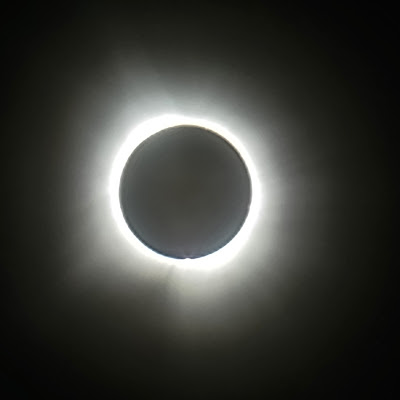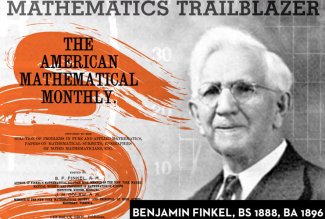
2024 marks the 130th anniversary of The American Mathematical Monthly.
The trailblazer who launched this premier academic journal in 1894 and inspired the establishment of the American Mathematical Association (AMA) graduated from Ohio Northern University in the late 1800s—Benjamin Franklin Finkel, BS 1888, BA 1896.
Mathematical problems fascinated Finkel from a young age, and his eagerness to solve them impelled his ambition to “publish a journal devoted solely to mathematics and suitable to the needs of teachers of mathematics.”
He once stated: “Many dormant minds have been aroused into activity through the mastery of a single problem.”
Over a century later, Finkel’s statement still rings true.
While much has changed at Ohio Northern since Finkel’s days, the University continues to attract brilliant problem-solvers molded in Finkel’s character who graduate to become leading mathematicians and physicists.
Read about three outstanding alumni from ONU’s School of Science, Technology, and Mathematics, housed in the Getty College of Arts & Sciences, who are making a mark in the world of physics and mathematics.
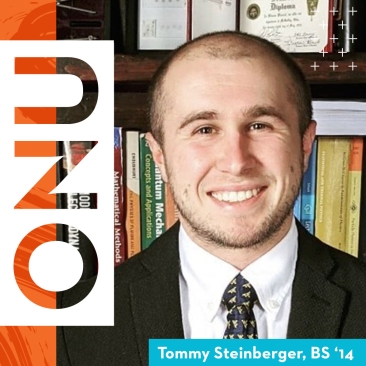 From algebra to plasma physics
From algebra to plasma physics
Thomas (Tommy) Steinberger, BS ’14, Ph.D., is breaking new ground in experimental plasma physics at West Virginia University in Morgantown, W.V.
A research assistant professor in the Department of Physics and Astronomy, he explores charged gas systems (plasmas), investigating gas particle motion and temperature. His work aims to enhance electronics manufacturing, space travel, and our understanding of space phenomena, such as magnetic reconnection.
“I come into the lab and can work on 10 different projects before lunch,” he said. “I have a lot of ongoing projects that are unique. Most of my effort is helping all these projects move forward.”
Steinberger’s journey began in freshman Algebra class in high school. While his classmates bellyached about having to solve 50 of the 100 algebra problems listed in the final exam, he felt a burst of excitement.
“I completed nearly all 100 in a couple of days, almost obsessively,” he recalled.
His ONU experience further ignited his passion for problem solving. He joined ONU-SOLVE, a problem-solving group of students that tackle the challenging problems found in leading math magazines such as Fibonacci Quarterly, Mathematics Magazine, The College Mathematics Journal, and Finkel’s own The American Mathematical Monthly.
ONU-SOLVE has been recognized multiple times in recent years for submitting correct solutions, and several have been published in leading journals as the most well-written solutions, according to Mihai Caragiu, Ph.D., professor of mathematics.
According to Steinberger, several solutions he worked on with the assistance of ONU professors received honorable mentions in academic magazines.
“My time at ONU really fostered my interest in math and its application to other fields,” he said. “I received fantastic instruction from professors who truly cared about their students.”
After graduating from ONU with a double major in mathematics and physics, and minor in astronomy, Steinberger received a master’s degree in physics and astronomy, and a Ph.D. in experimental plasma physics from West Virginia University.
“The challenge of the subjects (math and physics) resonates with my stubborn nature,” he added. “It leads me to be ever more persistent in my studies.”
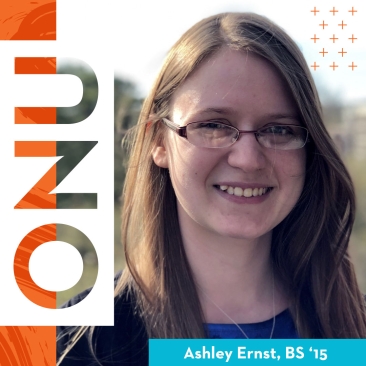 From jigsaw mastery to national defense
From jigsaw mastery to national defense
Ashley Ernst, BS ’15, Ph.D., is a senior physicist at Arcfield in Colorado Springs, Colo, where she helps to solve complex challenges in support of the United States’ most critical national security missions.
Arcfield is a leading provider of mission-focused systems engineering and integration capabilities to the U.S. Intelligence Community, Department of Defense, and other agencies.
Ernst is currently working primarily with simulation and modeling of radiation in both vacuum and in atmosphere or material. She develops technical documentation, presents work to clients, and performs calculations with the aid of software.
“There is always another problem on the horizon,” she says. “The quest for the solution to the next problem is what drives me every day.”
Growing up, Ernst loved to solve jigsaw puzzles with her mom. As her skill increased, so did her hunger for harder challenges.
“They became larger in puzzle number, smaller in puzzle piece size, and more complex in shape and design,” she said. “When that wasn’t enough, I started solving puzzles without guide pictures.”
When she first arrived at ONU, however, she lacked focus and felt extremely homesick. Her ONU professors noticed her struggles and made special efforts to engage her in math conferences and ONU-SOLVE. Professor Caragiu spurred her mind into action by exposing her to Graph Theory and Discrete mathematics.
“Having a direction for my mental energy definitely helped me,” she said.
Within a short time, she says, she was on a better path forward. “I would not be where I am today without their help. The math and physics programs at ONU nurture the search for knowledge. No matter the level, the program meets the student at that level and pushes them to the next level.”
After graduating from ONU with a double major in physics and applied mathematics, Ernst earned a master’s degree in physics and a Ph.D. in hadronic physics from Florida State University. Her second year of graduate school, she received a highly-competitive National Science Foundation (NSF) Graduate Research Fellowship, which she credits to the quality of education and one-on-one mentoring she received at ONU.
“Each student that passes through the math program at ONU is instilled with a sense of excitement regarding a problem. While that problem may change, that excitement stays,” she said.
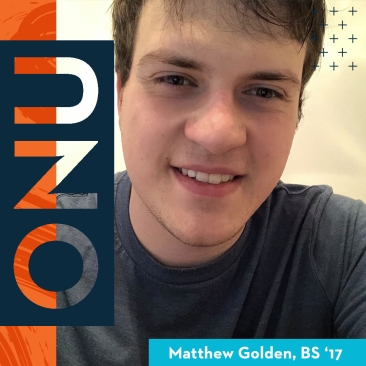 From twisty puzzles to cosmic enigmas
From twisty puzzles to cosmic enigmas
Matthew Golden, BS ’17, Ph.D., is a postdoctoral fellow at the Georgia Institute of Technology in the Xtreme Astrophysics group. The group is led by two founding members of the Event Horizon Telescope Collaboration, which released the first image of a black hole in 2019.
“I am a full-time researcher,” he said. “My research focuses on the interface of machine learning and physics. Specifically, I work on using machine learning to accelerate human learning. Our goal is to produce physics equations directly from complex data with minimal human intervention.” His recent publication in Science Advances showed how machine learning learned the equations of a living fluid directly from a video of the experiment.
In high school, Golden became enthralled with solving “twisty puzzles”—think Rubik’s cube, only the more complicated versions. He had puzzles of every platonic solid and with hundreds of pieces. Some would take him mere minutes to solve, others weeks.
“I eventually went on to solve the four-dimensional 3x3x3x3 Rubik’s cube,” he said. “You can find my name in the 4D Hall of Fame as solver #196.”
At ONU, his obsession switched to General Relativity. He spent many late nights in the Mathile Center for the Natural Sciences working through derivations. Then, he’d head to the third floor of Heterick Memorial Library, pull a random math or physics book from the shelf, and read until he was “hopelessly confused.”
“My schooling was significantly accelerated compared to the usual undergraduate,” he said. “That’s because the physics department was small and the teachers eager to teach at any pace.”
His professors allowed him to take courses in any order he desired. He completed Quantum Mechanics his first semester, then continued to grow his knowledge in leaps and bounds. He’ll never forget being the only student in Dr. Khristo Boyadzhiev’s Real Analysis class. Dr. Boyadzhiev, who obtained YouTube fame for his consistent classroom outfit and greeting, passed away in June 2023.
“It feels like half the people my age know Dr. Khristo Boyadzhiev because of his lovable appearance on Vine,” said Golden. “He was a micro celebrity, and I still remember him laughing about it in the hall.”
Golden also recalls leading a small group of students to first place in the 2017 Ohio MAA Leo Schneider Team Math Competition, dethroning Case Western Reserve University for the first time in many years.
With accelerated learning and one-on-one attention, Golden says he was way ahead of his peers in graduate school.
“The education I received was passionate and tailored to me,” he said. “There is no math program in the Midwest that could compete with the personal attention I received at ONU, and it paid off.”
He’s ecstatic that his professional career is centered on gravity research.
“I love that every day I get to think about machine learning and extreme astrophysical environments,” he said. “I get to interact with some of the greatest minds in physics.”



























